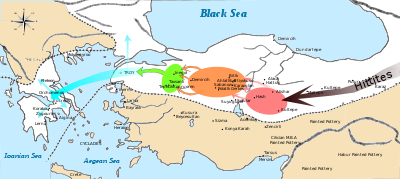- Middle Bronze Age migrations (Ancient Near East)
-
Various theories have been proposed that postulate waves of migration during the Middle Bronze Age in the Ancient Near East. While the turmoils that separate the Late Bronze Age from the Early Iron Age are well documented (see Bronze Age collapse), theories of migration during the Middle Bronze Age (20th century BCE) have little direct support.
Some suggestions connect these alleged "mass migrations" with the coming of the Greeks, moving from their former settlements into south and central Balkans displacing the former non-Greek inhabitants of Greece.[1][2][2][3] Others make reference to a supposed migration of the Hittites to their earliest known home in Kültepe during the same period.[4]
Contents
Background
Hittite invasion
For reasons unknown, the Hittites moved into Khattian Central Anatolia (Central Turkey), conquering the Hattians and later adopting their culture and name.[5] This invasion by the Hittites displaced other peoples living in Anatolia, who in turn displaced the Middle Helladic Greek-speaking peoples to the west. This enforced exodus from Northwestern Anatolia created a wave of refugees who invaded what is now southern Greece and destroyed the Early Helladic civilization.[3][6][7]
Destruction
Archaeological evidence shows that the cities of Erzerum, Sivas, Pulur Huyuk near Baiburt, Kultepe near Hafik, and Maltepe near Sivas all show destruction during this time. The great trading city of Kanesh (Level 2) was also destroyed. From there in the hill country between Halys the destruction layers from this time tell the same story. Karaoglan, Bitik, Polatli and Gordion are burnt as well as Etiyokusu, Cerkes. Further west near the Dardanelles the two large mounds of Korpruoren and Tavsanli, west of Kutahya, show the same signs of being razed to the ground. The destruction even crossed into Europe in what is now Bulgaria. The migration brought an end to Bulgaria's early Bronze age, with Archaeological evidence showing that the Yunacite, Salcutza, and Esero centers had a sudden mass desertion during this time.[6]
Into Greece
From the Dardanelles, the refugee invaders moved into mainland Greece, and the Peloponnese saw burnt and abandoned cities on par with the much later Dorian invasion which destroyed the Mycenaean civilization.[6] At this time, 1900 BCE, destruction layers can be found at southern Greek sites like Orchomenos, Eutresis, Hagios Kosmas, Raphina, Apesokari, Korakou, Zygouries, Tiryns, Asine, Malthi and Asea. Many other sites are deserted, e.g. Yiriza, Synoro, Ayios Gerasimos, Kophovouni, Makrovouni, Palaiopyrgos, etc. This destruction across Greece also coincided with the arrival of a new culture that had no connection with the Early Helladic civilization, who were the original inhabitants.[6]
Northern Greece escaped destruction, as well as southern Anatolia, which during this time showed no disturbances.[6]
Minyan ware
Main article: Minyan wareAccording to one view, supporting evidence of this mass movement of new populations into southern Greece may be seen in archaeology with the spread of "Minyan" ware throughout Greece around 1900 BC.[2][6] However, this has been disputed through excavations at Lerna showing that "Minyan" ware had a predecessor.[8] The advent of "Minyan" ware coincides with domestic processes reflective of the smooth transition from Early to Middle Bronze Age culture.[9]
See also
- Bronze Age Greece
- Bronze Age Anatolia
Bibliography
Notes
- ^ Geldard 2000, p. 7.
- ^ a b c Drews 1994, p. 14.
- ^ a b Dietrich 1974, p. 4.
- ^ Mellaart, James (January 1958). "The end of the early Bronze Age in Anatolia and the Aegean". American Journal of Archaeology vol 62 (no1).
- ^ Syndics 1964, p. 50.
- ^ a b c d e f Mellaart 1958, pp. 9-23.
- ^ James 2008, p. 150.
- ^ "Lesson 9: Middle Helladic Greece". Dartmouth College. 2009. Archived from the original on 2009-09-24. http://projectsx.dartmouth.edu/classics/history/bronze_age/lessons/les/9.html#8. Retrieved September 14, 2009.
- ^ Edwards 2000, p. 682. "Elsewhere the transition from Early to Middle Bronze Age culture seems to have been a smooth domestic process, unaffected by foreign influences. At individual sites, such as Troy, new wares take the place of old; but the arrival, for instance, of the so-called grey 'Minyan' pottery, which is now known to have been in use long before in neighbouring areas, suggests rather a peaceful acquisition rather than a foreign intrusion."
References
- Dietrich, Bernard Clive (1974). The Origins of Greek Religion. Walter de Gruyter. ISBN 3110039826.
- Drews, Robert (1994). The Coming of the Greeks: Indo-European Conquests in the Aegean and the Near East. Princeton University Press. ISBN 0691029512.
- Edwards, I. E. S. (2000). The Cambridge Ancient History, Volume 1 - Volume 3. Cambridge University Press. ISBN 0521077915.
- Geldard, Richard G. (2000). The Traveler's Key to Ancient Greece: A Guide to Sacred Places. Quest Books. ISBN 0835607844.
- James, Kevin (2008). A Mystery in Clay: Codes, Languages, and a Journey Through Time to the Last Ice Age. AuthorHouse. ISBN 1434376389.
- Mellaart, James (January 1958). "The End of the Early Bronze Age in Anatolia and the Aegean". American Journal of Archaeology 62 (1).
- The Syndics of the Cambridge University Press (1964). Anatolia. Cambridge University Press.
Categories:- Bronze Age Greece
- Bronze Age Anatolia
- Human migration
Wikimedia Foundation. 2010.

